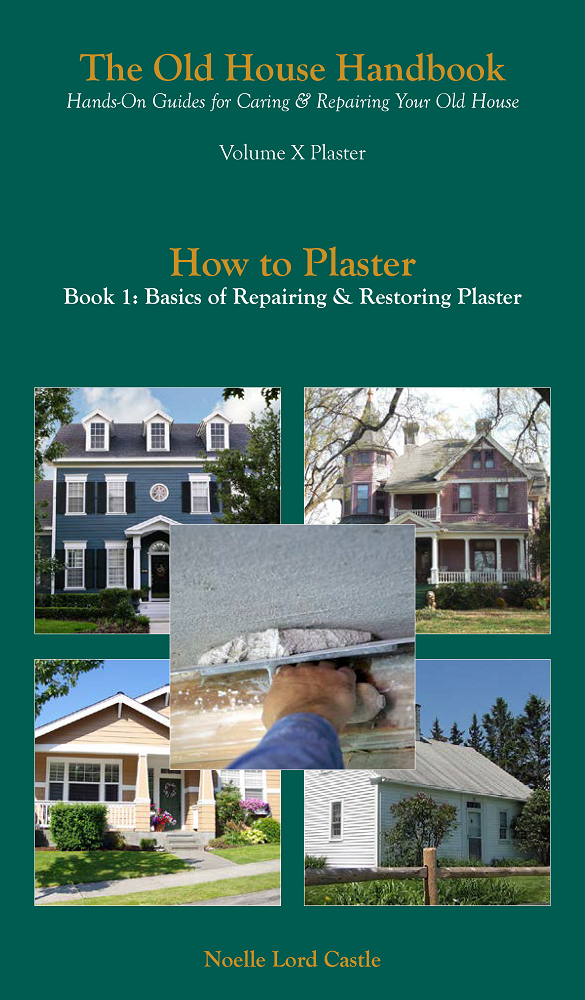Go Green: Insulation
While it is true that an entire house would be insulated in the ideal world, those of us with old houses know that we rarely get to operate within ideals – that is the charm and character we love so much in our old place!
Selecting the right products and installing them under the right conditions is critical to getting the results you want without unexpected outcomes. Many manufacturers and installers recommend insulation must have an R-value of R-38 – R-60 to be effective. These represent new construction applications and are simply not realistic when trying to retrofit.
This restorer, from experiences in my own old house and through unfortunate examples from countless clients, has seen little good come from the expensive effort of blowing in insulation. The unpredictable framing and large cavities of older construction means coverage is inconsistent and leaves the product to sink and rot timbers. We have also seen its installation blow the plaster off more than one wall! The best effort you can make is to insulate your attic floor. We recently added R-30 to our attic floor (along with proper ventilation) and noticed a dramatic improvement immediately proving something is better than nothing.
DON’T use chemical drain cleaners to unclog your toilet or other drains! These products are not only dangerous to your health, but can damage plumbing fixtures and pipes, and kill the good bacteria operating septic systems – creating costly repairs!
Baking soda, white vinegar, and soapy water, along with a tooth brush, are your best weapons for cleaning most areas – skip the harsh chemical and abrasive cleansers whenever possible. Harsh chemicals and toxic cleansers tend to be too corrosive on old building materials, and can seriously damage older pipes and fixtures. Avoid using vinegar on anything rubber like gaskets and seals, however, as it can dry out the surface and cause cracking.
When houses fall into disrepair and building materials are allowed to fail, energy loss becomes inevitable. Planning for routine maintenance and repairs allows you to address problems before they become major. One of the best ways to achieve this is to keep up with regular cleaning so surfaces are exposed and issues can be caught early.
When using an extension ladder, it should extend outward from the wall at least 1 foot for every 3 feet of height for a stable footing.
It is essential that air leaks are controlled. The Department of Energy estimates homeowners can save more than 10 % in energy costs simply by sealing off drafts that draw heat (and air conditioning) out of the house. Home efficiency efforts only work really well when both heat and air are controlled.
When using a sandable product such as Durabond, there is a tendency to scratch the plaster around the edges of your repair. To avoid this, use a stiff, wet sponge at the edges of your patch to avoid chasing your tail as you finish up your repair.
Replacing a broken pane of glass and reglazing a window pane takes a little practice, but is basically an easy chore. With the right hand tools and technique, you can get rid of poor glazing and buildup or a dangerous broken pane, and weather-tighten your window.
It is easiest to take the sash right out to work on, although this can be done in place. The pane of glass and all old glazing putty must be removed first using a stiff putty knife or chisel. If the glass is not broken, a careful hand working against the wood instead of the glass will avoid cracking the glass. The pane is held in place by small metal wedges called glazier’s points. Feel along for them and pry them out as you go. Gently work the pane out of the sash.
The grooves in the muntins and sash that the windowpane sits in is called a “rabbit” (if anyone knows why email me!). This area must be cleaned down to bare wood and primed with a quality oil-based product (or sealed with boiled linseed oil if natural) before reglazing or the wood will draw the moisture out of the glazing and dry it out.
If your windows are old enough to have nice wavy antique glass, find some more so your replacement doesn’t “glare” back as a later repair. Your local transfer station is a great resource, and most window repair shops will have some available. I have been seen in more than one dumpster pulling out old sashes for the glass.
Everyone complains that old glass is too brittle and difficult to cut. All glass is hard to cut without good technique. Hold the cutter firmly and make a single cut with a smooth, uninterrupted motion, then grip both sides of the cut line with even pressure to snap it. Don’t rush it, use a flat work surface, and have sharp, accurate tools ready.
The pane of glass should be 1/8 inch smaller in both dimensions than the opening. When the wood around the glass expands the pressure will crack the pane if it is cut to fit. Always dry-fit the glass, and put it aside in the same orientation that you fitted it.
Glazing compounds are available in oil-based (Dap 33) and water-based (Aqua Glaze) options. Oil-based is an easy to work with traditional favorite, but takes longer to skim over for painting. Water-based glazing tends to be much softer and stickier (wear “vinyl” gloves) so harder to control, but sets up quickly and can be painted the next day.
Use a putty knife to apply the back glaze in the rabbit, and gently push the window pane down evenly into the glazing until you can’t see the wood of the rabbit beneath the glass. Glazier’s points will further secure the glass in place (a 12 inch pane needs only 4). The flat triangles work best (with the accompanying tool to insert them); the ones with the lip are intended more for picture framing and leave a larger surface to have to cover with glazing. Push in the top glazing evenly around the pane.
Using a putty knife, cut into each corner and draw a line about 45-degrees along each side of the glass-glazing, and draw out at the ending corner; work your way around the pane. If you cut the line so you can slightly see the rabbit, the paint won’t show from the other side. Without touching the edges you just shaped, hold the knife in both hands for control and flip the excess putty toward the middle for easy pick up. Go back and clean up the angles in the corners, pulling the knife up and over the wood framing to protect the glazing. You will need to turn the window over and clean up the inside using the same cut and flip technique above.
Once the glazing is firm and skimmed over, it is ready to paint. To complete the weather-tight seal, the paint bead should run just slightly onto the glass.
As always when you are working on older painted surfaces, take lead paint precautions!
Lack of time, resources and expertise usually lead to poor decision-making where our older buildings are concerned. Unfortunately, there is rarely one answer or one way of doing things where older buildings are concerned. Just as the original approach to an architectural element was borne out of necessity and ingenuity, the solution to any given problem or desired outcome calls for the same kind of innovative thinking. This approach requires extra time and energy, leads to homeowner frustration and confusion, and is the first snare in the best-laid restoration plans. It is easy to fall into the trap of letting impatience and conflicting information influence an abrupt decision that will not serve the building (or your pocket book) in the long run. Enough research and the proper resources are keys to meeting this challenge head on and avoiding a classic pitfall.
Researching the history of your home and it original details will give you a solid foundation on which to plan repairs and improvements. You must also determine what options you have available to you today in terms of modern methods, materials and experts so that you have accurate and realistic choices. Skipping this necessary investigation to determine what period details would have been, what you have that is original and what are later “improvements” will leave you with an inaccurate picture and end products that look like patchwork instead of cohesive, complimentary designs and improvements. You need to have all the pieces of the puzzle to put it back together again, and you will have to dig around to find the missing pieces.
Resources come in the form of tradespeople and suppliers to provide the materials and services you require, how much personal time you have to give to the research and work, as well as the financial means to complete the work. Another huge restoration pitfall is getting the wrong information from an inexperienced person and believing you have no other choices. It takes determination and persistence to find preservation professionals to advise and assist, and the appropriate materials you require. Invest in this effort and you will know you have enough information to make an informed decision, and that you are spending your financial resources wisely. When you hear words like “never”, “can’t”, “not anymore”, and “no one” beware! All the resources are out there – just keep digging.
Before jumping in to complete a repair or project, it is important to step back and figure out what really needs to be done, what is causing the current situation, if it impacts other areas of the building or involves further work, and if you are being realistic in launching this project. Always develop a plan of attack ahead of time including the project timeline and priorities, professionals to depend upon, suppliers and your budget. Do not get caught in the trap of biting off more than you can manage, or starting a project without considering the domino effect it may have on other areas. This pitfall will force you to make quick decisions and “good enough” efforts that you will surely regret later.
Once you get started down the restoration and home improvement road, the projects most of us can’t wait to complete are usually the ones that have immediate gratification that we can see. Avoid investing in aesthetic improvements at the expense of the structural integrity of the building or good working order of major systems. Short-term “cures” can lead to more serious problems in the future. Using inferior quality products, hiring inexperienced people, performing cosmetic cover-ups, and just plain ignoring problems will create additional work and more expensive solutions down the road. If it sounds too easy it is, and “quickies” like painting over wallpaper is never easier in the end!
Nothing is more frustrating for a homeowner or tradesperson than going backwards. It is so important that projects are performed in a sequence that tackles any structural issues first, and does not undermine previous work. Things like finishing floors before the walls are repaired, restoring plaster before roof and chimney repairs are done, or completing landscaping before foundation and drainage improvements will leave you chasing your tail. Be sure structural integrity is the highest priority, and work outside – in, top – down to avoid frustrating and costly mistakes.
Rich with history and character, older buildings require a different mindset and approach to their upgrades and stewardship. They present a different set of variables and challenges – materials can be hard to find or replace, experienced tradespeople can be tough to locate, and working on something that already exists is always tougher than starting from scratch and building new. This being said, why go to the extra trouble, and usually additional expense, to restore your older building?
For many of us restoring an old place closer to its original condition, or simply maintaining the historic integrity we have, is a philosophical value. If it’s good, old workmanship, why throw it out? Besides, it feels good to take care of something, to bring something back. There are also many practical arguments for saving and preserving – it increases your property value, there may be tax credits available to you, many times materials are stronger than their modern counterparts, and historic areas attract more visitors to local businesses allowing a community to thrive. There are also aesthetic arguments – it looks better, feels better, and has more character than pre-fabricated, machine-created work.
There is a lot of confusion over what is restoration, what should be classified as “historic”, what time periods and details are significant, and why should someone go to the greater efforts to restore versus renovate or remodel. This is due in large part to the fact that restoration has become trendy, and the term often misleading. “Restoration” has been added to the names and tag lines of dozens of businesses from fixture suppliers to contractors to cleaning companies. As more companies jump on the bandwagon of “restoration” because it’s popular and a potential moneymaker, the term and the corresponding efforts become very muddy. The reality of what is happening on many projects can be far from restoration. Completely gutting a building’s interior so that systems can be upgraded easily, or removing all the walls of the first floor for an “open floor plan”, is not restoration. Without spending too much time on dictionary definitions or arguments of semantics, the general definition of restoration is to save what historic or original features are there and put back lost elements with ones most closely representing what might have been used.
If you are a homeowner conducting restoration efforts yourself, or if you are hiring professionals to help you, search for all the options to resolve issues and seriously consider those that do less damage to your original historic features. The essence of restoration is flexibility and creativity. “Thinking outside the box” is a cliché not lost on restoration! Of course, decisions have to be practical and judgment calls must be made, just think twice before taking a crowbar to anything. Sometimes there is not much left to save, most times there is plenty. You can complete necessary repairs, and make upgrades to meet current usage requirements and needs, and still be sensitively restoring your home.
What is important is that decisions are informed ones, based on research and information, not marketing pitches. Be sure you are comparing apples to apples when getting advice, quotes and estimates. Know the difference between efforts that reflect restoration versus its cousins: renovation, rehabilitation and remodeling. Hopefully historic value is always a consideration before something new is a replacement, and that you realize what you may be losing as well as what you may be gaining. We feel guilty throwing a soda can into the trash. Wouldn’t it be nice if we felt the same responsibility before sending all the old plaster to the dump? Think of restoration as the ultimate recycling.

TOT: Avoid Harsh Drain Cleansers
DON’T use chemical drain cleaners to unclog your toilet or other drains! These products are not only dangerous to your health, but can damage plumbing fixtures and pipes, and kill the good bacteria operating septic systems – creating costly repairs!

